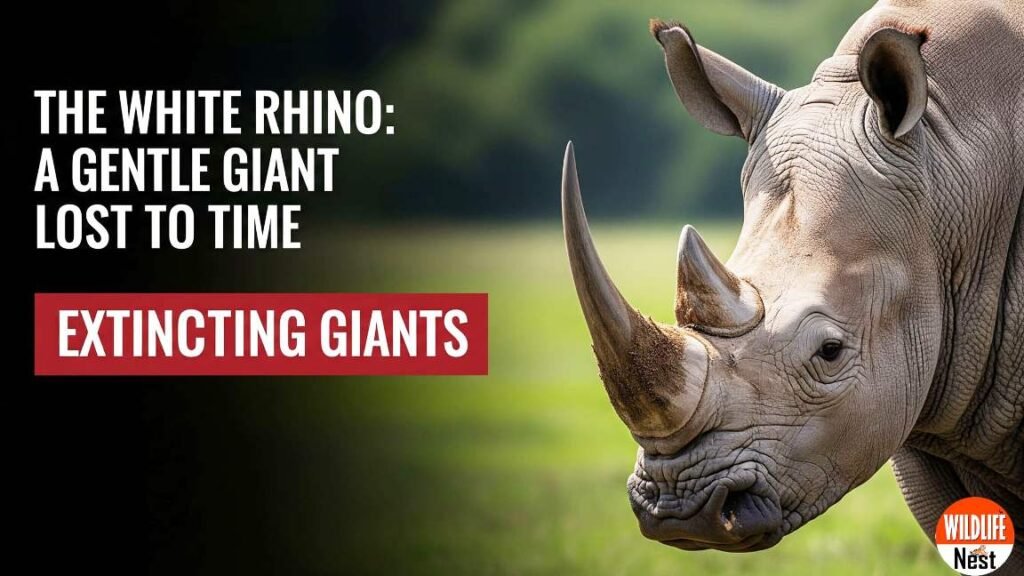The story of the White Rhino is one of both wonder and deep sorrow. Known as one of the largest and most iconic land mammals, the White Rhinoceros (Ceratotherium simum) once roamed vast parts of Africa, shaping its grasslands and inspiring awe in everyone lucky enough to see it. Today, however, the species stands as a stark symbol of how human greed and neglect can push even the mightiest creatures to the edge — and sadly, over it.

A Brief History of the White Rhino
There are actually two distinct subspecies of White Rhino: the Southern White Rhino (Ceratotherium simum simum) and the Northern White Rhino (Ceratotherium simum cottoni). Both shared the same broad, square-shaped mouth adapted for grazing, which made them the largest pure grazers among rhinos.
- Southern White Rhino: This subspecies historically ranged throughout southern Africa — South Africa, Namibia, Zimbabwe, and parts of Botswana. Through decades of conservation efforts, their population was once brought back from fewer than 100 individuals in the late 1800s to over 20,000 in recent decades.
- Northern White Rhino: The Northern cousin lived across Central and East Africa — Uganda, Chad, Sudan, the Central African Republic, and the Democratic Republic of Congo. Tragically, political instability, civil wars, and relentless poaching devastated this population.
The Rhino Horn Crisis
White Rhinos became prime targets for poachers due to their large horns, which, despite being made of keratin (the same protein as human hair and nails), have been falsely marketed as cures for various ailments in some traditional Asian medicines and as status symbols. This black market trade decimated rhino populations faster than conservationists could protect them.
Conservation Battles
The Southern White Rhino story gave hope to conservationists worldwide. Strict protection and successful breeding programs in reserves and parks like South Africa’s Hluhluwe-iMfolozi Park and Kruger National Park revived their numbers spectacularly. They became a global conservation success story.
However, the Northern White Rhino was not so fortunate. Habitat loss and political turmoil made conservation in its native range nearly impossible. Despite desperate translocations and protective efforts, their numbers dwindled alarmingly fast.
Declared Extinct in the Wild
The final blow came in March 2018 when Sudan, the last male Northern White Rhino, died in Kenya’s Ol Pejeta Conservancy, leaving only two surviving females — Najin and Fatu. With no males left, natural reproduction became impossible. Advanced scientific attempts, like in vitro fertilization using stored sperm and surrogate mothers, are ongoing but have yet to revive a self-sustaining population.
In recent conservation records, the Northern White Rhino has now been formally declared extinct in the wild. Only these two females survive under 24-hour armed guard — a living reminder of a species that once thundered freely across African plains.
Why Should We Care?
Rhinos, especially grazers like the White Rhino, play a vital role in their ecosystems. They shape landscapes, maintain grassland diversity, and support countless other species. Losing them doesn’t just mean losing a magnificent animal — it means disrupting the entire ecological balance of their habitats.
A Call to Action
The fate of the White Rhino teaches us an urgent lesson: protecting endangered species requires relentless global cooperation, strong local enforcement, and respect for nature over profit. We must learn from this tragedy to prevent other creatures, like the Black Rhino and Javan Rhino, from following the same path.
A Glimmer of Hope
All is not entirely lost. The Southern White Rhino still survives, thanks to vigilant conservationists, wildlife rangers, and supportive governments and communities. Biotechnology and innovative science continue to explore ways to possibly resurrect the Northern White Rhino population using preserved genetic material.
In closing, the White Rhino’s story is bittersweet — a testament to human capability for both destruction and redemption. May this gentle giant forever remind us why every creature deserves a fighting chance.
White Rhino FAQ
1. What is a White Rhino?
The White Rhino is one of the largest species of rhinoceros and the second largest land mammal after the elephant. It’s known for its broad, square-shaped mouth, which helps it graze on grasses.
2. Are there different types of White Rhinos?
Yes! There are two subspecies: the Southern White Rhino, which still survives in protected areas, and the Northern White Rhino, which has sadly been declared extinct in the wild.
3. Why are they called “White” Rhinos?
Interestingly, it has nothing to do with their color! The name likely comes from a misinterpretation of the Afrikaans word “wyd” meaning “wide”, referring to their wide mouth — not their color.
4. Why did the Northern White Rhino go extinct?
Mainly due to relentless poaching for their horns and habitat loss. Civil wars and lack of security in their home ranges also made conservation extremely difficult.
5. How many Northern White Rhinos are left today?
Only two females remain — Najin and Fatu. There are no living males left, so they can’t reproduce naturally anymore.
6. Can science bring back the Northern White Rhino?
Scientists are trying! Using advanced techniques like in vitro fertilization (IVF) and stored sperm, they hope to create embryos and implant them into surrogate rhino mothers. It’s very challenging but offers a glimmer of hope.
7. What about the Southern White Rhino? Are they safe?
They’re doing better! Thanks to decades of protection and conservation, about 16,000–18,000 Southern White Rhinos exist today. However, they still face poaching threats and need constant protection.
8. Why do people want rhino horns?
Unfortunately, myths in some cultures claim rhino horn can cure various illnesses or act as a status symbol. In reality, rhino horn is just keratin — like human hair and nails — and has no medicinal properties.
9. What can we do to help rhinos?
Support trusted wildlife conservation organizations, never buy products made from rhino horn, and spread awareness about protecting wildlife. Every small effort counts!
10. Where can I see White Rhinos safely today?
You can visit reputable national parks and conservancies in southern Africa, like South Africa’s Kruger National Park or Kenya’s Ol Pejeta Conservancy — always choosing ethical safari operators that prioritize wildlife welfare.
Watch Wildlife Awareness Videos
For more engaging and educational content on snakes and other wild creatures, don’t forget to visit our official YouTube channel: www.youtube.com/@WildlifeNest
Subscribe and explore fascinating wildlife stories, awareness videos, and rare sightings—all brought to you by Wildlife Nest!
Related Posts Table
| Title | Read Article |
|---|---|
| Wildlife Sanctuaries in India | Read More |
| Complete History of TATR | Read More |
| The History of Lions in India | Read More |
| Gir National Park Guide | Read More |
| Explore Tadoba | Read More |
| Ultimate Guide to Kanha National Park | Read More |
Related Snake Species – Explore More on Wildlife Nest
| Snake Species / Topic | Read Article |
|---|---|
| Indian Rat Snake | Read Article |
| Common Sand Boa Snake | Read Article |
| Indian Rock Python | Read Article |
| Two Step Snake | Read Article |
| King Cobra Secrets – Study Breaks 180 Year Myth | Read Article |
| Slender Coral Snake | Read Article |
| The Green Vine Snake – An In-Depth Look | Read Article |
| Common Cat Snake – All Information | Read Article |
| Banded Krait Snake – All Information | Read Article |
| King Cobra – All Information | Read Article |
| Common Krait – All Information | Read Article |
| Russell’s Viper | Read Article |
| Saw Scaled Viper Snake – All Information | Read Article |
| Cobra Snake – All Information | Read Article |
| The Big Four Snakes of India | Read Article |
| What Are Reptiles? | Read Article |
| The Deadliest Venom | Read Article |
| Most Dangerous Snakes in the World | Read Article |
| The Ultimate Guide to Snakes | Read Article |
| History of Snakes – Evolution, Habitats, Survival | Read Article |


